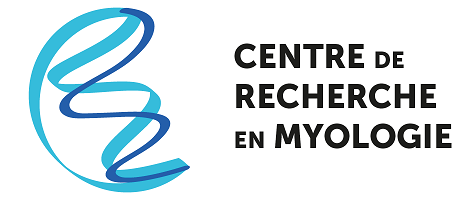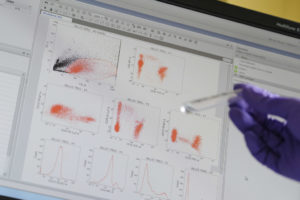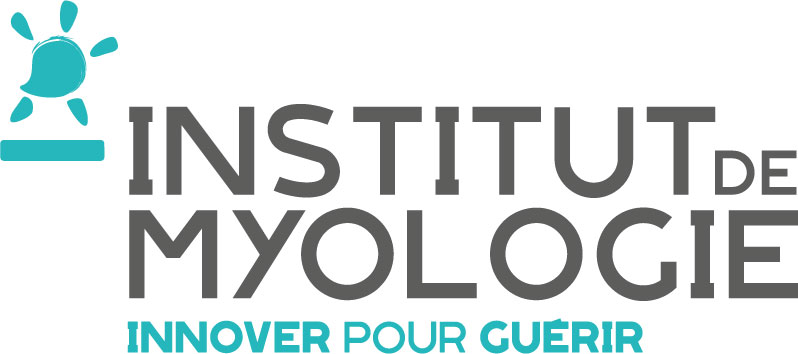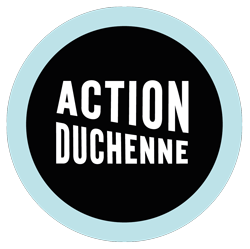Gene therapy for DMD and pathophysiology of skeletal muscle
Gene therapy for DMD and pathophysiology of skeletal muscle
The dystrophinopathies are pathologies caused by anomalies in the DMD gene encoding for a protein called dystrophin. This protein is absent in Duchenne muscular dystrophy (DMD) while it is present but qualitatively and/or quantitatively altered in the Becker muscular dystrophy (BMD). It is known that the modular structure of dystrophin tolerates large internal deletions. This observation led to the development of two main therapeutic strategies: classical gene therapy with transfer of functional mini- or micro-dystrophin cDNAs in muscles, and targeted exon skipping. Exon skipping strategy, using antisense molecules or gene therapy with AAV-U7, converts an out-of-frame mutation into an in-frame mutation leading to an internally deleted dystrophin. However, in preclinical DMD models, dystrophin restoration by AAV-U7-mediated exon-skipping therapy was shown to drastically decrease after one year in treated animals. We recently showed that pre-treating dystrophic mice muscle with a single dose of peptide-phosphorodiamidate morpholino (PPMO) antisense oligonucleotides led to transitory dystrophin expression at the sarcolemma and allowed efficient maintenance of AAV genomes enhancing significantly the long-term effect of AAV-U7 therapy. Currently, we evaluate this combined treatment by addressing the benefit of systemic injection of therapeutic PPMO and AAV-U7 vector to a severe DMD model (dystrophin/utrophin double-knockout mouse (dKO)). These mice suffer from a much more severe and progressive muscle wasting, heart and diaphragm functions, impaired mobility and premature death, mimicking pathophysiology of DMD patients.
Phenotypic and genomic characterization of Becker dystrophy patients with 45 to 55 exons deletion
BMD displays 1/30000 live births incidence and is characterized by a progressive muscular dystrophy with or without cardiomyopathy. We present a population of 49 BMD patients with a DMD gene in-phase deletion of exons 45 to 55 (BMDdel45-55). As described, 63% of Duchenne patients are eligible to a multiexon skipping therapy by skipping exons 45 to 55 transforming DMD to BMDdel45-55 patients, it is thus crucial to study the genomic/phenotype link in this BMD cohort. Interestingly, emerging regulatory actors as lncRNA are localized in introns 44 and 55. Thus, the specific neo-introns of each patient could create or modify the lncRNA and/or RNA non-coding sequences. The objective of this study is to identify modifier factors involved in phenotypic variability in BMDdel45-55 patients We performed (i) a phenotypic characterization of 49 patients, (ii) a lncRNA profile in 40/49patients and (iii) a WGS in 19/49patients.
Proteins connecting voltage sensing with muscle mass homeostasis
Deciphering the mechanisms governing skeletal muscle plasticity is essential for understanding pathophysiological processes, including muscle dystrophy and age-related sarcopenia. Muscle activity reverses atrophy, but the connection between these processes is unknown. The voltage sensor CaV1.1 has a central role in excitation–contraction coupling, raising the possibility that it may also initiate the adaptive response to changes in muscle activity. We revealed the existence of a transcription switch for the beta subunit of CaV1.1 (CaVβ1) that depends on the innervation state of the muscle. We showed that denervation increases the expression of a novel embryonic isoform, CaVβ1E. CaVβ1E boosts downstream GDF5 signaling to counteract muscle loss after denervation. We reported that aged muscle expresses significantly reduced levels of CaVβ1E and that CaVβ1E overexpression in aging muscle reduces mass waste by rescuing GDF5 expression. Crucially, we also identified human CaVβ1E and showed a tight negative correlation between hCaVβ1E expression and age-related muscle decline in people, suggesting that the mechanisms underlying muscle mass homeostasis are conserved across species. Actually, we have preliminary data indicating a promising therapeutic approach to improve age-related muscle waste due to the implementation of the recombinant protein (rGdf5).

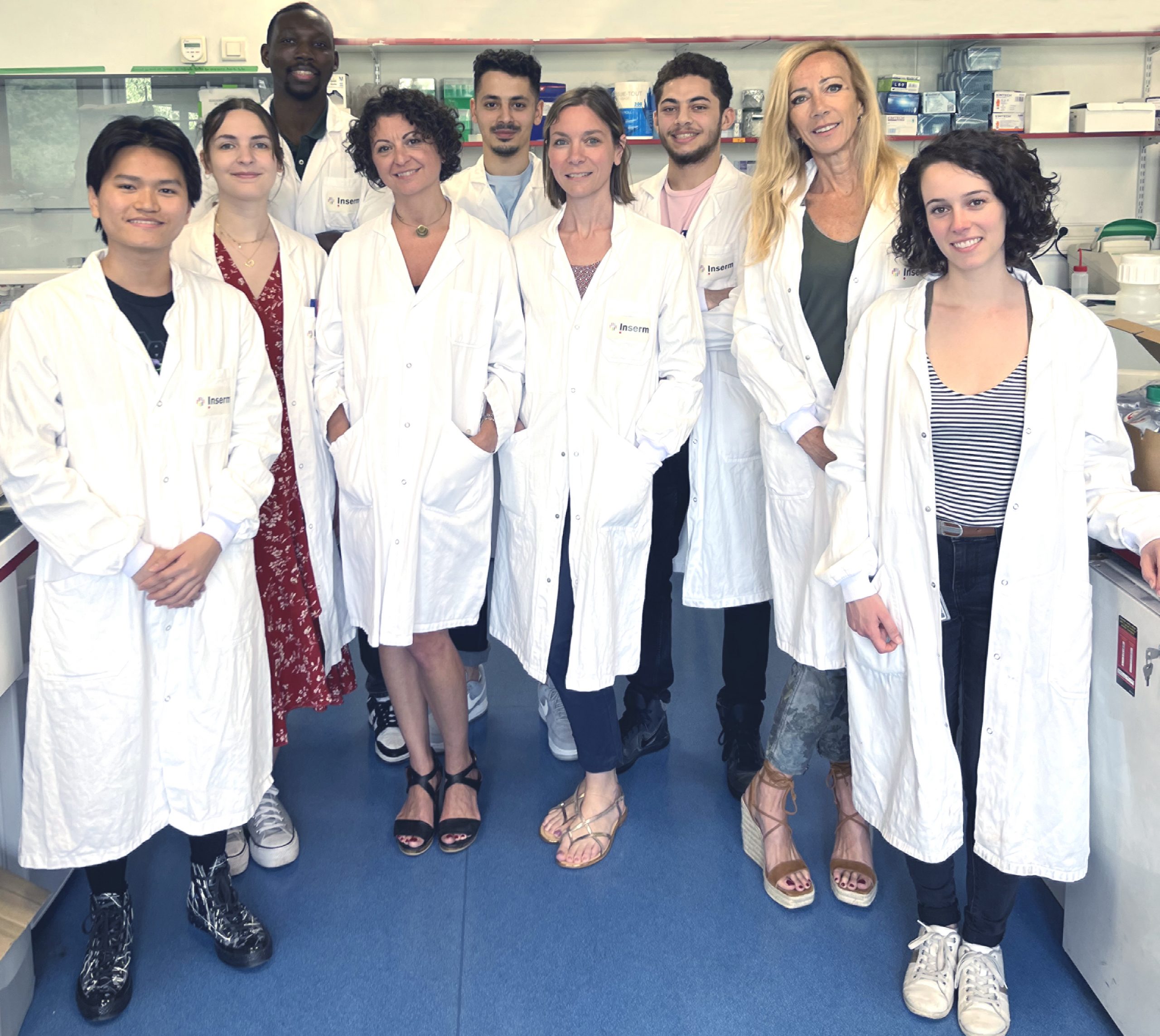
Contacts :
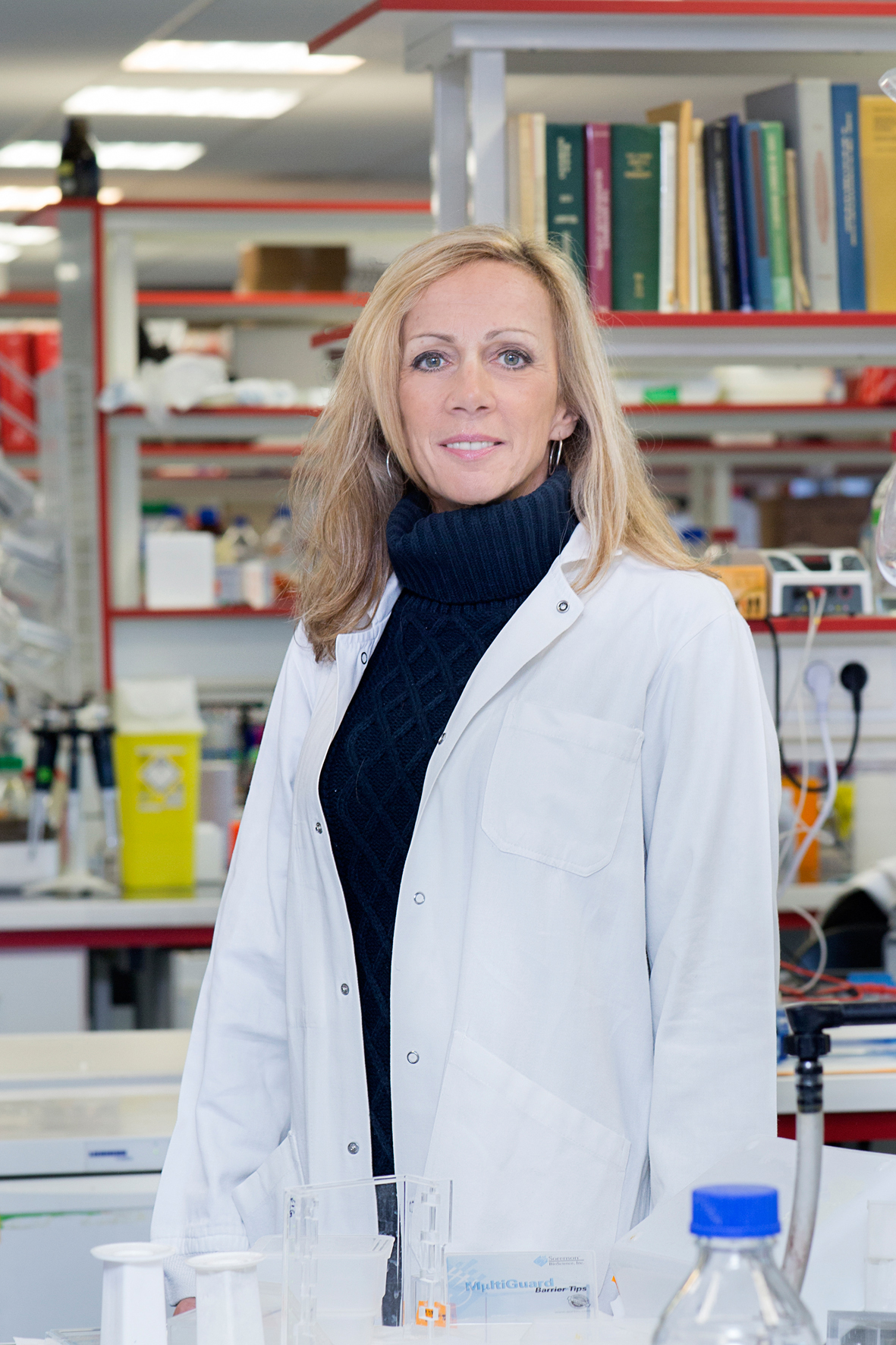
| Name | Position | ORCID |
|---|
Journal articles
- Julie Chassagne, Nathalie da Silva, Ines Akrouf, Bruno Cadot, Laura Julien, et al.. Early endosome disturbance and endolysosomal pathway dysfunction in Duchenne muscular dystrophy. American Journal of Pathology, 2025, 195 (9), pp.1627-1642. ⟨10.1016/j.ajpath.2025.05.007⟩. ⟨hal-05364696⟩
- Amélie Vergnol, Aly Bourguiba, Stephanie Bauché, Massiré Traoré, Maxime Gelin, et al.. Identification of CaVβ1 Isoforms Required for Neuromuscular Junction Formation and Maintenance. Cells, 2025, 14 (15), pp.1210. ⟨10.3390/cells14151210⟩. ⟨hal-05337131⟩
- Anne Forand, Sophie Moog, Nathalie Mougenot, Mégane Lemaitre, Caroline Sevoz-Couche, et al.. Long-term dystrophin replacement therapy in Duchenne muscular dystrophy causes cardiac inflammation. JACC : Basic to Translational Science, 2025, 10 (6), pp.759-782. ⟨10.1016/j.jacbts.2024.12.015⟩. ⟨hal-05337141⟩
- Davide Cervia, Silvia Zecchini, Luca Pincigher, Paulina Roux-Biejat, Chiara Zalambani, et al.. Oral administration of plumbagin is beneficial in in vivo models of Duchenne muscular dystrophy through control of redox signaling. Free Radical Biology and Medicine, 2024, 225 (11), pp.193-207. ⟨10.1016/j.freeradbiomed.2024.09.037⟩. ⟨hal-05046911⟩
- Valentina Taglietti, Kaouthar Kefi, Busra Mirciloglu, Sultan Bastu, Jean-Daniel Masson, et al.. Progressive cardiomyopathy with intercalated disc disorganization in a rat model of Becker dystrophy. EMBO Reports, 2024, 25 (11), pp.4898 - 4920. ⟨10.1038/s44319-024-00249-9⟩. ⟨hal-04782182⟩
- Massiré Traoré, Chiara Noviello, Amélie Vergnol, Christel Gentil, Marius Halliez, et al.. GDF5 as a rejuvenating treatment for age-related neuromuscular failure. Brain - A Journal of Neurology , 2024, 147, pp.3834 - 3848. ⟨10.1093/brain/awae107⟩. ⟨hal-04760455⟩
- Chiara Noviello, Kassandra Kobon, Voahangy Randrianarison-Huetz, Pascal Maire, France Piétri‐rouxel, et al.. RhoA Is a Crucial Regulator of Myoblast Fusion. Cells, 2023, 12 (23), pp.2673. ⟨10.3390/cells12232673⟩. ⟨hal-04782193⟩
- Valentina Taglietti, Kaouthar Kefi, Lea Rivera, Oriane Bergiers, Nastasia Cardone, et al.. Thyroid-stimulating hormone receptor signaling restores skeletal muscle stem cell regeneration in rats with muscular dystrophy. Science Translational Medicine, 2023, 15 (685), ⟨10.1126/scitranslmed.add5275⟩. ⟨hal-04150315⟩
- A. Morin, Amalia Stantzou, Olga N. Petrova, John C.W. Hildyard, T. Tensorer, et al.. Dystrophin myonuclear domain restoration governs treatment efficacy in dystrophic muscle. Proceedings of the National Academy of Sciences of the United States of America, 2023, 120 (2), ⟨10.1073/pnas.2206324120⟩. ⟨hal-04122777⟩
- Amédée Mollard, Cécile Peccate, Anne Forand, Julie Chassagne, Laura Julien, et al.. Muscle regeneration affects Adeno Associated Virus 1 mediated transgene transcription. Scientific Reports, 2022, 12 (1), pp.9674. ⟨10.1038/s41598-022-13405-9⟩. ⟨hal-03828271⟩
- Valentina Taglietti, Kaouthar Kefi, Iwona Bronisz-Budzyńska, Busra Mirciloglu, Mathilde Rodrigues, et al.. Duchenne muscular dystrophy trajectory in R-DMDdel52 preclinical rat model identifies COMP as biomarker of fibrosis. Acta Neuropathologica Communications, 2022, 10 (1), ⟨10.1186/s40478-022-01355-2⟩. ⟨hal-03828280⟩
- Alexis Boulinguiez, Christian Duhem, Alicia Mayeuf-Louchart, Benoit Pourcet, Yasmine Sebti, et al.. NR1D1 controls skeletal muscle calcium homeostasis through myoregulin repression. JCI Insight, 2022, 7 (17), ⟨10.1172/jci.insight.153584⟩. ⟨hal-03828260⟩
- Antoine de Zélicourt, Abdallah Fayssoil, Mbarka Dakouane‐giudicelli, Isley de Jesus, Ahmed Karoui, et al.. CD38‐NADase is a new major contributor to Duchenne muscular dystrophic phenotype. EMBO Molecular Medicine, 2022, 14 (5), pp.e12860. ⟨10.15252/emmm.202012860⟩. ⟨hal-03619994⟩
- Amélie Vergnol, Massiré Traoré, France Pietri-Rouxel, Sestina Falcone. New Insights in CaVβ Subunits: Role in the Regulation of Gene Expression and Cellular Homeostasis. Frontiers in Cell and Developmental Biology, 2022, 10, pp.880441. ⟨10.3389/fcell.2022.880441⟩. ⟨hal-03829511⟩
- Francisco Jaque-Fernández, Gonzalo Jorquera, Jennifer Troc-Gajardo, France Pietri-Rouxel, Christel Gentil, et al.. Pannexin-1 and Ca V 1.1 show reciprocal interaction during excitation-contraction and excitation-transcription coupling in skeletal muscle. Journal of General Physiology, 2021, 153 (12), ⟨10.1085/jgp.202012635⟩. ⟨hal-03797282⟩
- Francesca Grassi, Sestina Falcone. Report and Abstracts of the 18th Meeting of the Interuniversity Institute of Myology: Virtual meeting, October 21-24, 2021. European Journal of Translational Myology, 2021, 30 (4), ⟨10.4081/ejtm.2021.10270⟩. ⟨hal-03463314⟩
- Elena Gargaun, Sestina Falcone, Guilhem Sole, Julien Durigneux, Andoni Urtizberea, et al.. The lncRNA 44s2 Study Applicability to the Design of 45-55 Exon Skipping Therapeutic Strategy for DMD. Biomedicines, 2021, 9 (2), pp.219. ⟨10.3390/biomedicines9020219⟩. ⟨hal-03163543⟩
- Anne Forand, Antoine Muchir, Nathalie Mougenot, Caroline Sévoz-Couche, Cécile Peccate, et al.. Combined Treatment with Peptide-Conjugated Phosphorodiamidate Morpholino Oligomer-PPMO and AAV-U7 Rescues the Severe DMD Phenotype in Mice. Molecular Therapy - Methods and Clinical Development, 2020, 17, pp.695-708. ⟨10.1016/j.omtm.2020.03.011⟩. ⟨hal-02569939⟩
- Massiré Traoré, Christel Gentil, Chiara Benedetto, Jean-Yves Hogrel, Pierre de La Grange, et al.. An embryonic CaVβ1 isoform promotes muscle mass maintenance via GDF5 signaling in adult mouse. Science Translational Medicine, 2019, 11 (517), ⟨10.1126/scitranslmed.aaw1131⟩. ⟨hal-02382706⟩
- T. Dufor, S. Grehl, A. Tang, M. Doulazmi, Massiré Traoré, et al.. Neural circuit repair by low-intensity magnetic stimulation requires cellular magnetoreceptors and specific stimulation patterns. Science Advances , 2019, 5 (10), pp.eaav9847. ⟨10.1126/sciadv.aav9847⟩. ⟨hal-03843646⟩
- E. Gargaun, K. Wahbi, R. Ben Yaou, M. Guibaud, G. Solé, et al.. Phenotypic and genomic characterization as predictors of DMD 45 to 55 multi-exon skipping therapy. Neuromuscular Disorders, 2019, 29, pp.S165. ⟨10.1016/j.nmd.2019.06.449⟩. ⟨cea-04414398⟩
- Agathe Franck, Jeanne Lainé, Gilles Moulay, Eline Lemerle, Michaël Trichet, et al.. Clathrin plaques and associated actin anchor intermediate filaments in skeletal muscle. Molecular Biology of the Cell, 2019, 30 (5), pp.579-590. ⟨10.1091/mbc.E18-11-0718⟩. ⟨hal-02136143⟩
- Sara Charawi, Pierre-Alexandre Just, Mathilde Savall, Shirley Abitbol, Massiré Traore, et al.. LKB1 signaling is activated in CTNNB1 -mutated HCC and positively regulates β-catenin-dependent CTNNB1 -mutated HCC. Journal of Pathology, 2019, 247 (4), pp.435-443. ⟨10.1002/path.5202⟩. ⟨hal-02365767⟩
- Anaïs Fongy, Sestina Falcone, Jeanne Lainé, Bernard Prudhon, Aurea Martins-Bach, et al.. Nuclear defects in skeletal muscle from a Dynamin 2-linked centronuclear myopathy mouse model. Scientific Reports, 2019, 9, pp.1580. ⟨10.1038/s41598-018-38184-0⟩. ⟨hal-02024929⟩
- Olivier Delalande, Anne-Elisabeth Molza, Raphael dos Santos Morais, Angélique Chéron, Emeline Pollet, et al.. Dystrophin's central domain forms a complex filament that becomes disorganized by in-frame deletions. Journal of Biological Chemistry, 2018, 293 (18), pp.6637-6646. ⟨10.1074/jbc.M117.809798⟩. ⟨hal-01795395v2⟩
- Marine Guilbaud, Christel Gentil, Cecile Peccate, Elena Gargaun, Isabelle Holtzmann, et al.. miR-708-5p and miR-34c-5p are involved in nNOS regulation in dystrophic context. Skeletal Muscle, 2018, 8 (1), pp.15. ⟨10.1186/s13395-018-0161-2⟩. ⟨hal-01792009⟩
- Delphine Trochet, Bernard Prudhon, Maud Beuvin, Cécile Peccate, Stéphanie Lorain, et al.. Allele‐specific silencing therapy for Dynamin 2‐related dominant centronuclear myopathy. EMBO Molecular Medicine, 2018, 10 (2), pp.239-253. ⟨10.15252/emmm.201707988⟩. ⟨hal-02000303⟩
- Laura Julien, Julie Chassagne, Cécile Peccate, Stéphanie Lorain, France Pietri-Rouxel, et al.. RFX1 and RFX3 Transcription Factors Interact with the D Sequence of Adeno-Associated Virus Inverted Terminal Repeat and Regulate AAV Transduction. Scientific Reports, 2018, 8 (1), pp.210. ⟨10.1038/s41598-017-18604-3⟩. ⟨hal-02382992⟩
- John Rendu, Rodrick Montjean, Charles Coutton, Mohnish Suri, Gaetan Chicanne, et al.. Functional Characterization and Rescue of a Deep Intronic Mutation in OCRL Gene Responsible for Lowe Syndrome. Human Mutation, 2017, 38 (2), pp.152-159. ⟨10.1002/humu.23139⟩. ⟨hal-03828357⟩
- Mafalda Pimentel, Sestina Falcone, Bruno Cadot, Edgar Gomes. In Vitro Differentiation of Mature Myofibers for Live Imaging. Journal of visualized experiments : JoVE, 2017, 119, ⟨10.3791/55141⟩. ⟨hal-03687569⟩
- Caroline Godfrey, Lourdes Desviat, Bård Smedsrød, France Piétri-Rouxel, Michela Denti, et al.. Delivery is key: lessons learnt from developing splice‐switching antisense therapies. EMBO Molecular Medicine, 2017, 9 (5), pp.545-557. ⟨10.15252/emmm.201607199⟩. ⟨hal-03828351⟩
- Christel Gentil, Caroline Le Guiner, Sestina Falcone, Jean-Yves Hogrel, Cecile Peccate, et al.. Dystrophin threshold level necessary for normalisation of nNOS, iNOS and RyR1 nitrosylation in GRMD dystrophinopathy. Human Gene Therapy, 2016, 27 (9), pp.712-726. ⟨10.1089/hum.2016.041⟩. ⟨hal-01340106⟩
- Cécile Peccate, Amédée Mollard, Maëva Le Hir, Laura Julien, Graham Mcclorey, et al.. Antisense pre-treatment increases gene therapy efficacy in dystrophic muscles. Human Molecular Genetics, 2016, 25, pp.3555 - 3563. ⟨10.1093/hmg/ddw201⟩. ⟨hal-01590933⟩
- Sestina Falcone, William Roman, Karim Hnia, Vincent Gache, Nathalie Didier, et al.. N‐ WASP is required for Amphiphysin‐2/ BIN 1‐dependent nuclear positioning and triad organization in skeletal muscle and is involved in the pathophysiology of centronuclear myopathy. EMBO Molecular Medicine, 2014, 6 (11), pp.1455-1475. ⟨10.15252/emmm.201404436⟩. ⟨hal-03339560⟩
- Stéphane Vassilopoulos, Christel Gentil, Jeanne Lainé, Pierre-Olivier Buclez, Agathe Franck, et al.. Actin scaffolding by clathrin heavy chain is required for skeletal muscle sarcomere organization. Journal of Cell Biology, 2014, 205 (3), pp.377-393. ⟨10.1083/jcb.201309096⟩. ⟨hal-02453865⟩
- K. Relizani, E. Mouisel, B. Giannesini, C. Hourde, K. Patel, et al.. Blockade of ActRIIB signaling triggers muscle fatigability and metabolic myopathy. Molecular Therapy, 2014, 22 (8), pp.1423-1433. ⟨10.1038/mt.2014.90⟩. ⟨hal-02881194⟩
- Hong S. Lee, Stephan Ripke, Benjamin M. Neale, Stephen V. Faraone, Shaun M. Purcell, et al.. Genetic relationship between five psychiatric disorders estimated from genome-wide SNPs. Nature Genetics, 2013, 45 (9), pp.984-994. ⟨10.1038/ng.2711⟩. ⟨inserm-00864642⟩
- John Rendu, Julie Brocard, Eric Denarier, Nicole Monnier, France Piétri-Rouxel, et al.. Exon skipping as a therapeutic strategy applied to an RYR1 mutation with pseudo-exon inclusion causing a severe core myopathy.. Human Gene Therapy, 2013, 24 (7), pp.702-13. ⟨10.1089/hum.2013.052⟩. ⟨inserm-00904818⟩
- Bruno Cadot, Vincent Gache, Elena Vasyutina, Sestina Falcone, Carmen Birchmeier, et al.. Nuclear movement during myotube formation is microtubule and dynein dependent and is regulated by Cdc42, Par6 and Par3. EMBO Reports, 2012, 13 (8), pp.741-749. ⟨10.1038/embor.2012.89⟩. ⟨hal-03687577⟩
- Silvia Brunelli, Clara de Palma, Sestina Falcone, Serena Pisoni, Sara Cipolat, et al.. Nitric oxide inhibition of Drp1-mediated mitochondrial fission is critical for myogenic differentiation. Cell Death and Differentiation, 2010, ⟨10.1038/cdd.2010.48⟩. ⟨hal-00535922⟩
- France Piétri-Rouxel, Christel Gentil, Stéphane Vassilopoulos, Dominique Baas, Etienne Mouisel, et al.. DHPR alpha1S subunit controls skeletal muscle mass and morphogenesis.. EMBO Journal, 2010, 29 (3), pp.643-54. ⟨10.1038/emboj.2009.366⟩. ⟨inserm-00515849⟩
- France Piétri-Rouxel, Christel Gentil, Stéphane Vassilopoulos, Dominique Baas, Etienne Mouisel, et al.. DHPR α1S subunit controls skeletal muscle mass and morphogenesis. EMBO Journal, 2009, 29, pp.643 - 654. ⟨ensl-00817432⟩
- Christel Gentil, Sébastien Le Jan, Josette Philippe, Jacques Leibowitch, Pierre Sonigo, et al.. Is oxygen a key factor in the lipodystrophy phenotype?. Lipids Health Dis, 2006, 5, pp.27. ⟨10.1186/1476-511X-5-27⟩. ⟨inserm-00122143⟩
- Olivier Neyrolles, Rogelio Hernández-Pando, France Pietri-Rouxel, Paul Fornès, Ludovic Tailleux, et al.. Is Adipose Tissue a Place for Mycobacterium tuberculosis Persistence?. PLoS ONE, 2006, 1, pp.e43. ⟨10.1371/journal.pone.0000043⟩. ⟨pasteur-00130276⟩
- Caroline Petit, France Piétri-Rouxel, Annick Lesne, Thierry Leste-Lasserre, Dominique Mathez, et al.. Oxygen consumption by cultured human cells is impaired by a nucleoside analogue cocktail that inhibits mitochondrial DNA synthesis. Mitochondrion, 2005, 5 (3), pp.154-161. ⟨10.1016/j.mito.2004.09.004⟩. ⟨hal-03140777⟩
- G. Leclerc, E. Nicolle, A. El Hadri, M.-C. Guillaume, F. Pietri-Rouxel, et al.. Synthesis and bovine beta-3 adrenergic agonistic activities of a novel series of aryloxypropanolamines.. Archiv der Pharmazie / Arch Pharm Pharm Med Chem; Arch Pharm Chem Life Sci; Arch Pharm (Weinheim), 2001, 56, pp.517-522. ⟨hal-00123266⟩
- V. Zilberfarb, F. Pietri-Rouxel, Ralf Jockers, Simon Krief, Claude Delouis, et al.. Human immortalized brown adipocytes express functional bêta3-adrenoceptor coupled to lipolysis. Journal of Cell Science, 1997, 110, pp.801-807. ⟨hal-02686235⟩
Conference papers
- Chiara Noviello, Massiré Traoré, Bruno Cadot, Lucile Saillard, Béatrice Matot, et al.. Exploring the protective role of GDF5 against skeletal muscle disuse atrophy. 19th IIM Meeting, Oct 2022, Assisi (Perugia), France. ⟨hal-04020147⟩
- Amélie Vergnol. Role of MuscleBlind-Like proteins in the regulation of expression of CaVβ1 isoforms in adult skeletal muscle. World Muscle Society 2022, Oct 2022, Halifax (Canada), France. ⟨hal-03999572⟩
- Massiré Traoré. Therapeutic approach based on GDF5 to counteract age-related muscle wasting. Myology 2022, AFM-TELETHON, Sep 2022, Nice, France. ⟨hal-03997646⟩
- Massiré Traoré. Therapeutic approach based on GDF5 to counteract age-related muscle wasting. Myology 2022, AFM-TELETHON, Sep 2022, Nice, France. ⟨hal-04001213⟩
- France Piétri‐rouxel. GDF5 therapeutic potential for Duchenne Muscular Dystrophy gene therapy optimization. 12th Japanese-French Workshop “New insights in personalized medicine for neuromuscular diseases: From Basic to Applied Myology”, Gisèle Bonne, Sep 2022, Giverny, France. ⟨hal-04000417⟩
- Sestina Falcone. Therapeutic approach based on GDF5 to counteract age-related muscle wasting. 5ème Congrès de la Société de Physiologie et Biologie Intégrative (SPBI), Jun 2022, Lyon, France. ⟨hal-03998857⟩
- France Piétri‐rouxel. AAV- microDystrophin and AAV-GDF5: A combined treatment to optimize DMD gene therapy ?. EMBO 2022 Muscle formation, maintenance, regeneration and pathology, Fred Relaix, Apr 2022, Gouvieux, France. ⟨hal-04000437⟩
- Sestina Falcone. An embryonic CaVβ1 isoform promotes muscle mass maintenance via GDF5 signaling in adult mouse.. 17ème Journée de la societé française de myologie 2019, Nov 2019, Marseille (FR), France. ⟨hal-04001941⟩
- Sestina Falcone, Massiré Traoré, Christel Gentil, Chiara Benedetto, Jean-Yves Hogrel, et al.. rGdf5, an unexpected treatment against age-related muscle mass loss. 24th International Annual Congress of the World Muscle Society, Oct 2019, Copenhague, Denmark. ⟨hal-04002488⟩
- Massiré Traoré. A novel Cavβ1 isoform connecting voltage sensing with muscle mass homeostasis. 6ème Congrès International de Myologie 2019, AFM-TELETHON, Mar 2019, Bordeau, France. ⟨hal-03997517⟩
- Sestina Falcone. rGdf5, an unexpected treatment against age-related muscle mass loss. Myology 2019, Mar 2019, Bordeaux (FR), France. ⟨hal-04001930⟩
- C. Gentil, C. Le Guiner, Yan Cherel, M. Montus, P. Moulier, et al.. Dystrophin rescue needed to recover a correct location of nNOS and the return to a normalized RyR1 status in treated GRMD dogs. 18. International Congress of The World Muscle Society, Oct 2013, Asilomar, California, United States. ⟨10.1016/j.nmd.2013.06.701⟩. ⟨hal-02747723⟩
Poster communications
- Aly BOURGUIBA VILLENEUVE, Sonia Pezet, Christel Gentil, Massiré Traoré, Julien Messéant, et al.. GDF5 therapeutic potential on neuromuscular junction defects. IIM 2024, Sep 2024, Assisi (Perugia), Italy. ⟨hal-05364850⟩
- France Piétri‐rouxel, Aly BOURGUIBA VILLENEUVE, Sestina Falcone, Sonia Pezet, Massiré Traoré, et al.. Unraveling the role of GDF5 therapeutic potential in Amyotrophic Lateral Sclerosis. Myology 2024, Apr 2024, Paris, France. ⟨hal-04782464⟩
- Amélie Vergnol, Alain Sureau, Eric Batsché, Eric Allemand, Massiré Traoré, et al.. CaVβ1A and CaVβ1E embryonic isoforms in adult skeletal muscle, a Mbnl1 related-expression. Myology 2024, Apr 2024, Paris, France. ⟨hal-04782481⟩
- Christel Gentil, Amélie Vergnol, Aly BOURGUIBA VILLENEUVE, Lucile Saillard, Cadot Bruno, et al.. GDF5 overexpression improves pathophysiology of DMD in mdx muscle. Myology 2024, Apr 2024, Paris, France. ⟨hal-04782437⟩
- Sestina Falcone, Marais T., Traoré M., Bourguiba A., Gentil C., et al.. Unraveling the role of GDF5 therapeutic potential in Amyotrophic Lateral Sclerosis. 19 Journée de la societé Française de Myologie, Nov 2022, Toulouse (FR), France. ⟨hal-04002173⟩
- Massiré Traoré. GDF5 as rejuvenating treatment for age-related neuromuscular failure. Journées annuelles de la Société Française de Myologie 2022, Nov 2022, Toulouse, France. ⟨hal-03997704⟩
- Amélie Vergnol, Alain Sureau, A. Traoré, X. Lornage, G. Gourdon, et al.. Role of MuscleBlind-Like proteins in the regulation of expression of CaVβ1 isoforms in adult skeletal muscle. 19èmes Journées de la Société Française de Myologie, Nov 2022, Toulouse (FRANCE), France. ⟨hal-03999589⟩
- Amélie Vergnol, Alain Sureau, A. Traoré, X. Lornage, G. Gourdon, et al.. Role of MuscleBlind-Like proteins in the regulation of expression of CaVβ1 isoforms in adult skeletal muscle. World Muscle Society 2022, Oct 2022, Halifax (Canada), France. ⟨hal-03999596⟩
- Chiara Noviello, Massiré Traoré, Bruno Cadot, Lucile Saillard, Béatrice Matot, et al.. Exploring the protective role of GDF5 against skeletal muscle disuse atrophy. Myology Conference 2022, Sep 2022, Nice (FRANCE), France. ⟨hal-04020141⟩
- Sestina Falcone, T. Marais, M. Traoré, C. Gentil, J. Mésseant, et al.. Unraveling the role of GDF5 therapeutic potential in Amyotrophic Lateral Sclerosis. Myology 2022, Sep 2022, Nice (FRANCE), France. ⟨hal-04002164⟩
- Amélie Vergnol, Alain Sureau, A. Traoré, X. Lornage, G. Gourdon, et al.. Role of MuscleBlind-Like proteins in the regulation of expression of CaVβ1 isoforms in adult skeletal muscle. Myology 2022, Sep 2022, Nice (FRANCE), France. ⟨hal-03999540⟩
- Christel Gentil, Lucile Saillard, Amélie Vergnol, Lorenzo Giordani, Bruno Cadot, et al.. GDF5 therapeutic potential for DMD. Myology 2022, Sep 2022, Nice, France. ⟨hal-03994325⟩
- Massiré Traoré, Chiara Noviello, Gentil Christel, Julien Messéant, Ericky Caldas, et al.. Therapeutic approach based on GDF5 to counteract age-related muscle wasting. Muscle formation, maintenance, regeneration and pathology-EMBO workshop, Apr 2022, Gouvieux (FR), France. ⟨hal-04002159⟩
- Massiré Traoré. Therapeutic approach based on GDF5 to counteract age-related muscle loss. Journées annuelles de la Société Française de Myologie 2021, Nov 2021, Saint-Etienne, France. ⟨hal-03997686⟩
- Sestina Falcone, T. Marais, M. Traoré, C. Gentil, J. Mésseant, et al.. Unraveling the role of GDF5 therapeutic potential in Amyotrophic Lateral Sclerosis. 18ème Journée de la Societé Française de Myologie, Nov 2021, Saint-Etienne (FR), France. ⟨hal-04002180⟩
- Christel Gentil, Lucile Saillard, Amélie Vergnol, Lorenzo Giordani, Bruno Cadot, et al.. GDF5 therapeutic potential for DMD. SFM 2021, Nov 2021, St Etienne, France. ⟨hal-03994315⟩
- Gilles Moulay, Isabelle Nelson, Jeanne Lainé, Enzo Cohen, Mégane Lemaître, et al.. The α2-subunit of the AP2 clathrin adaptor as a new causal gene in an atypical myopathy with granulofilamentous inclusions. Congress of the World Muscle Society, Sep 2021, Virtual, France. 2021. ⟨hal-03967904⟩
- Massiré Traoré. rGDF5, an unexpected treatment against age-related muscle loss. Journées annuelles de la Société Française de Myologie, Nov 2019, Marseille, France. ⟨hal-03997530⟩
- Anne Forand, Antoine Muchir, Nathalie Mougenot, Caroline Sevoz-Couche, Cécile Peccate, et al.. PPMO pre-treatment is beneficial for AAV-based gene therapy in Duchenne Muscular Dystrophy. Myologie 2019, Mar 2019, Bordeaux, France. ⟨hal-03996969⟩
- Elena Gargaun, Rabah Ben Yaou, Marine Guibaud, Guilhem Solé, Vincent Tiffreau, et al.. Phenotypic and genomic characterization of Becker dystrophy patients with 45 to 55 exons deletion. Sixth internatinal congress of myology Myology2019, Mar 2019, Bordeaux (France), France. ⟨hal-04015218⟩
- Elena Gargaun, Rabah Ben Yaou, Guilhem Solé, Vincent Tiffreau, Pascale Laforet, et al.. Caractérisation phénotypique et génomique des patients Becker avec délétion des exons 45-55. 29ème Congrès de la Société Française de Neurologie Pédiatrique, Jan 2019, Strasbourg (FRANCE), France. ⟨hal-04015227⟩
- Massiré Traoré. Cavβ1: The missing link from voltage sensing to muscle mass homeostasis. 15th Interuniversity Institute of Myology Meeting, Pathogenesis and Therapies of Neuromuscular Diseases, Oct 2018, Assise, Italy. ⟨hal-03997593⟩
- M Traoré, C Benedetto, P de la Grange, J.Y. Hogrel, France Piétri‐rouxel, et al.. CaVb1: The missing link from voltage sensing to muscle mass homeostasis. Molecular mechanisms of muscle wasting during aging and disease, Sep 2018, Ascona (CH), Switzerland. ⟨hal-04002366⟩
- Julie Chassagne, Laura Julien, Cécile Peccate, Stéphanie Lorain, France Piétri-Rouxel, et al.. RFX1 and RFX3 Transcription Factors Interact with the D Sequence of Adeno-Associated Virus Inverted Terminal Repeat and Regulate AAV Transduction. European Society of Gene and Cell Therapy, 2018, Lausanne, Switzerland. 2018. ⟨hal-03968317⟩
- Sestina Falcone, C. Benedetto, M Traoré, P. de la Grange, A. Ferry, et al.. From voltage sensing to gene expression in the control of muscle mass homeostasis. 22nd World Muscle Society Congress, Oct 2017, Saint-Malo (France), France. ⟨hal-04002388⟩
Patents
- Sestina Falcone, France Piétri‐rouxel. POLYTHÉRAPIE POUR MALADIES MUSCULAIRES. France, N° de brevet: EP4054618. 2022. ⟨hal-04012059⟩
- Sestina Falcone, France Piétri‐rouxel. COMPOSITIONS POUR LE TRAITEMENT DE LA SARCOPÉNIE OU DE L'ATROPHIE PAR INACTION. France, N° de brevet: EP3823662. 2021. ⟨hal-04011322⟩
Preprints, Working Papers
- Christel Gentil, Aly Bourguiba, Amélie Vergnol, Bruno Cadot, Zoheir Guesmia, et al.. GDF5 modulation of MuSC pool as a potential therapeutic benefit for DMD. 2025. ⟨hal-05364772⟩
Theses
- Amélie Vergnol. The CaVβ1 isoforms : role in neuromuscular junction formation and implication in Myotonic Dystrophy type 1 pathophysiology. Cellular Biology. Sorbonne Université, 2024. English. ⟨NNT : 2024SORUS305⟩. ⟨tel-04833678⟩
- Elena Gargaun. Genotypic and phenotypic characterization of Becker patients with deletion of exons 45 to 55. Life Sciences [q-bio]. Sorbonne Universite, 2020. English. ⟨NNT : ⟩. ⟨tel-04007931⟩
- Marine Guilbaud. Identification d'ARNs non-codants impliqués dans les dystrophinopathies. Biologie cellulaire. Sorbonne Université, 2018. Français. ⟨NNT : 2018SORUS042⟩. ⟨tel-02121057⟩
Patents
WO2016198676A1 publication Critical patent/WO2016198676A1 COMBINED THERAPY FOR DUCHENNE MUSCULAR DYSTROPHY Lorain et al.
EP18 184861.5 and 19 152677.1 COMPOSITIONS FOR THE TREATMENT OF SARCOPENIA OR DISUSE ATROPHY Piétri-Rouxel & Falcone
EP19207561.2.COMBINED THERAPY FOR MUSCULAR DISEASES Piétri-Rouxel & Falcone
